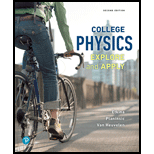
Concept explainers
BIO Resonance vibration transfer and the ear When you push a person on a swing, a series of snail pushes timed to match the swinger's swinging frequency makes the person swing with larger amplitude. If timed differently, the pushing is ineffective. The board shown in Figure 10.17 (from the Exploratorium in San Francisco) is made of rods of different length with identical balls on the ends of each rod Each rod vibrates at a different natural frequency, the long rod on the left at lower frequency and the short rod on the right at higher frequency if you shake the board at the high frequency at which the short rod vibrates, the short rod swings with large amplitude while the others swing a little if you shake the board at the middle frequency at which the two center rods vibrate, the center rods undergo large-amplitude vibrations and the rods on each end do not vibrate imagine now that you have a fancy board with 10.000 rods, each of slightly different length, the shortest on the left and the longest on the right. Shaking the board at a particular frequency causes the rods in one small region of the board to vibrate a: this frequency and has little effect on the others.
The inner ear (the cochlea) is a little Ike this fancy board Sound reaching the tympanic membrane, or eardrum, is greatly amplified by three tiny bones in the middle ear—the hammer, anvil and stirrup (Figure 10.18) These bones vibrate, pushing on the fluid in the inner ear and causing vibrations along its entire length. A basilar membrane with about 15.000 hair cells passes along the center of the inner ear. The basilar membrane is narrow and staff near the entrance to the inner car and wide and more flexible near the end When a single-frequency vibration causes the fluid to vibrate, the membrane and the hair cells respond best at a single place—high frequencies near the oval window and low frequencies near the end of the basilar membrane The bending of these hairs causes those nerve cells to fire. Thus, we detect the frequency of the sound by the part of the membrane from which the nerve signal comes.
If you shake the board shown in Figure 10.17 at a frequency higher than the natural frequency of the rod on the right, then what happens?
a. None of the rods vibrate.
b. All of the rods vibrate.
c. The shortest rod vibrates.
d. The longest rod vibrates.
e. The middle rods vibrate.
Want to see the full answer?
Check out a sample textbook solution
Chapter 10 Solutions
EBK COLLEGE PHYSICS
Additional Science Textbook Solutions
Chemistry: An Introduction to General, Organic, and Biological Chemistry (13th Edition)
Microbiology with Diseases by Body System (5th Edition)
Cosmic Perspective Fundamentals
Human Physiology: An Integrated Approach (8th Edition)
Organic Chemistry (8th Edition)
Applications and Investigations in Earth Science (9th Edition)
- 8. With the aid of a diagram draw the following electric circuit and use the resistor as the load, (a) Closed circuit (b) Open circuitarrow_forwardLab 8 Part 3 PHET Wave Interface simulation. I am having trouble with this part of the lab.arrow_forwardMick and Rick are twins born on Earth in the year 2175. Rick grows up to be an Earth-bound robotics technician while Mick becomes an intergalactic astronaut. Mick leaves the Earth on his first space mission in the year 2200 and travels, according to his clock, for 10 years at a speed of 0.75c. Unfortunately, at this point in his journey, the structure of his ship undergoes mechanical breakdown and the ship explodes. How old is Rick when his brother dies?arrow_forward
 College PhysicsPhysicsISBN:9781938168000Author:Paul Peter Urone, Roger HinrichsPublisher:OpenStax College
College PhysicsPhysicsISBN:9781938168000Author:Paul Peter Urone, Roger HinrichsPublisher:OpenStax College Physics for Scientists and Engineers, Technology ...PhysicsISBN:9781305116399Author:Raymond A. Serway, John W. JewettPublisher:Cengage Learning
Physics for Scientists and Engineers, Technology ...PhysicsISBN:9781305116399Author:Raymond A. Serway, John W. JewettPublisher:Cengage Learning University Physics Volume 1PhysicsISBN:9781938168277Author:William Moebs, Samuel J. Ling, Jeff SannyPublisher:OpenStax - Rice University
University Physics Volume 1PhysicsISBN:9781938168277Author:William Moebs, Samuel J. Ling, Jeff SannyPublisher:OpenStax - Rice University Glencoe Physics: Principles and Problems, Student...PhysicsISBN:9780078807213Author:Paul W. ZitzewitzPublisher:Glencoe/McGraw-Hill
Glencoe Physics: Principles and Problems, Student...PhysicsISBN:9780078807213Author:Paul W. ZitzewitzPublisher:Glencoe/McGraw-Hill Principles of Physics: A Calculus-Based TextPhysicsISBN:9781133104261Author:Raymond A. Serway, John W. JewettPublisher:Cengage Learning
Principles of Physics: A Calculus-Based TextPhysicsISBN:9781133104261Author:Raymond A. Serway, John W. JewettPublisher:Cengage Learning Physics for Scientists and EngineersPhysicsISBN:9781337553278Author:Raymond A. Serway, John W. JewettPublisher:Cengage Learning
Physics for Scientists and EngineersPhysicsISBN:9781337553278Author:Raymond A. Serway, John W. JewettPublisher:Cengage Learning





